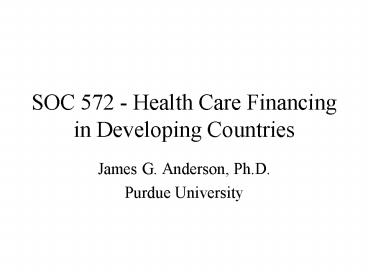SOC 572 Health Care Financing in Developing Countries - PowerPoint PPT Presentation
1 / 20
Title:
SOC 572 Health Care Financing in Developing Countries
Description:
OECD countries spend 10 times as much as low income countries. A disproportionate share of limited public health spending is being allocated to tertiary care ... – PowerPoint PPT presentation
Number of Views:74
Avg rating:3.0/5.0
Title: SOC 572 Health Care Financing in Developing Countries
1
SOC 572 - Health Care Financing in Developing
Countries
- James G. Anderson, Ph.D.
- Purdue University
2
Developing Regions of the World
- East Asia and the Pacific
- Europe and Central Asia
- Latin America and the Caribbean
- Middle East and North Africa
- South Asia
- Sub-Saharan Africa
3
Global Spending on Health
- 2.3 trillion in 1994
- 9 of total global income
4
Global Distribution of Income, Health Spending,
and Population, 1994
5
Global Disease Burden Disability-Adjusted Life
Years (DALYs)
- 1.4 trillion DALYs
- 7 Industrialized nations
- 93 Developing countries
6
Global Disease Burden in Millions of
Disability-Adjusted Life Years (DALYs) Lost, 1990
7
Economic and Health Sector Indicators
- Per capita GDPs in developing countries less than
10 industrialized countries - Mortality under age five in developing countries
is 10 times industrialized countries - Mortality among adults in developing countries is
two times industrialized countries - Industrialized countries have three times as many
physicians as developing countries - Industrialized countries have six times as many
hospital beds as developing countries
8
Key Economic and Health-Sector Indicators, By
Region and Income Level, 1994
9
Health Spending Patterns
- OECD countries spend 100 times as much as low
income countries - OECD countries spend 10 times as much as low
income countries - A disproportionate share of limited public health
spending is being allocated to tertiary care - Primary care services are inefficiently provided
and of poor quality
10
Health Spending, By Region and Income Level
(Country-Weighted Averages), 1994
11
Health Spending and per capita GDP
- There is a strong relationship between health
spending and GDP - Income elasticity of per capita health spending
relative to per capita GDP is 1.13 - Income elasticity of per capita health (public)
spending relative to per capita GDP is 1.21
12
Health Spending and per capita GDP
- For high income countries, income elasticity of
per capita health spending relative to per capita
GDP is 1.47. - For middle income countries, income elasticity of
per capita health spending relative to per capita
GDP is 1.19. - For low income countries, income elasticity of
per capita health spending relative to per capita
GDP is 1.00.
13
Relationship Between Per Capita Health Spending
And Per Capita GDP, In Exchange Rate-Based U.S.
Dollars, 1994
14
Public Share of Health Spending and Per Capita
GDP, in Exchange Rate-Based U.S. Dollars, 1994
15
Health Spending As a Percentage of Per Capita
GDP, 1994
16
Problems in Developing Countries
- Higher disease burden
- Severe resource constraints
- Limited administrative capacity
- Competing critical priorities
17
Basic Issues in Health Care ReformLow Income
Group
- Limited government budgets finance most public
health expenditures - External assistance is a significant revenue
source - Options for formal insurance schemes are
extremely limited - Households rely on informal arrangements,
extended families,and community support systems - Key issues Innovative use of informal
risk-pooling mechanisms expanding coverage to
the poor
18
Basic Issues in Health Care ReformMiddle Income
Group
- These countries show a tendency toward the
expansion of multiple financing sources. Some
are adopting social security schemes others, a
national health service - There is growth in private spending for private
health services - Many countries lack universal coverage
- Key issues Development of social insurance or
other formal risk-pooling arrangements expanding
insurance coverage to rural sectors
19
Basic Issues in Health Care ReformHigh Income
Group
- All countries except the U.S. have achieved
universal coverage - Most countries have public financing that is
either publicly managed or publicly mandated - Private insurance is used to supplement core
services covered by public financing - Key issues Cost containment, efficiency, quality
of care, aging population, patient satisfaction
20
Reference
- G. Schieber and A. Maeda, Health Care Financing
and Delivery in Developing Countries, Health
Affairs, Vol. 18, No. 3, May/June, 1999, pp.
193-205.































